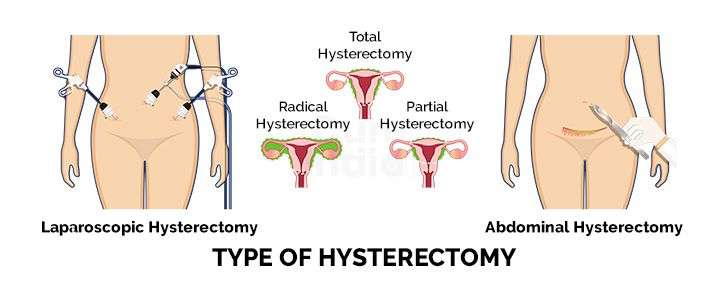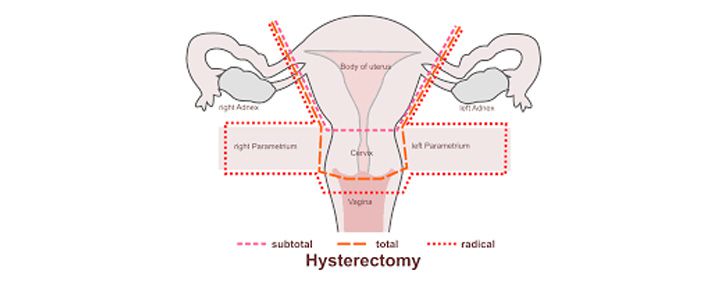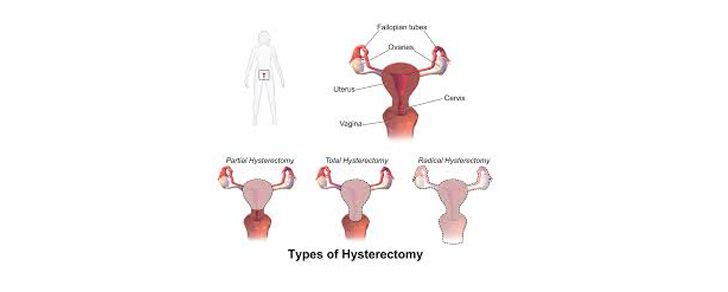

Hysterectomy is a surgery performed to remove the uterus. This is most common in women and is preferable done through laparoscopy. Studies show that 300 out of 10000 women undergo a hysterectomy. When the uterus develops fibroids, a hysterectomy needs to be performed to remove the uterine fibroids. Let us see in detail the reasons for hysterectomy. After a hysterectomy, a woman will neither have her periods nor can she get pregnant.

Some of the most common reasons include:
As mentioned earlier, one of the most common reasons for uterus removal is the presence of fibroids. Also known as uterine fibroids, these are non-cancerous extra growths of the uterus. The reason for this growth is not known. Although these are harmless, chances are that they might turn into cancerous tumours and lead to uterine cancer. A majority of these growths are harmless, yet they possess a potential risk and can cause medical problems in women.
Reasons for hysterectomy for fibroids are:
a. Excessive size of the fibroids
b. Severe bleeding during periods accompanied by pain and anaemia
When the vaginal wall is weak, the pelvic floor becomes heavy. Due to this childbearing becomes a problem. For women post-pregnancy, heaviness is pelvic floor causes pain and pressure. There is a noticeable loss of urine when they laugh, sneeze, jump or do any sort of physical activity that puts a little stress on the abdomen. Hysterectomy is a mandatory procedure to be performed when these symptoms begin to worsen.
Hysterectomy is done with different methods based on the symptoms, needs and condition of the patient. Let us see in detail the different types.

A laparoscopic hysterectomy is done with the help of laser technology as opposed to the traditional open hysterectomy. In this method, the incisions are made inside the belly and a small camera is inserted via it. Once inside, the camera starts to capture the images of the uterus, ovaries and other organs surrounding it, thus helping and aiding the doctors with a clear picture of the internal organs and allowing them to complete the surgery without any complications. The laparoscopy technique ensures that the patient does not feel any discomfort, pain or complications, has fewer stitches, and is a comparatively easy procedure compared with others. With this procedure, the patient can get back to her daily routine quickly as this is hassle-free.
This method includes surgical removal of the uterus alone and no other associated parts. Since this involves removal of the uterus alone, the surgery is quite fast and simple and the blood loss is comparatively lesser. The surgical hysterectomy procedure involved is also simple and takes comparatively lesser time than other hysterectomies. The women who have undergone this surgery can return back to their routine within a week.
Total hysterectomy is the process of removing the uterus and the cervix. When performed with a laparoscope, it is called Total Laparoscopic Hysterectomy (TLH). In this procedure, uterus removal is done through small incisions or through the vagina. TLH is only performed when women experience painful periods, pelvic pain and uterus fibroids. Under these circumstances, TLH is performed. The operation procedure in TLH is the same as in all laparoscopic hysterectomies where a small incision is made in the abdomen and then a laparoscopy in inserted.
TLH has some complications in women who have narrow vaginal walls. When the vaginal walls of the woman are very small and the uterus cannot be removed through it, then the doctors cut the vagina and take out the uterus. In some cases, the doctors do not opt for this method. Uterus removal happens in small pieces through small incisions.
This hysterectomy surgery, however, poses some complications such as:
1. Injury to the internal organs especially urinary tract
2. Bowel dysfunction
3. Hot flashes
4. Longer time for recovery
Since this a major surgery, some precautions are needed to be taken before the surgery. The doctors need to explain the side effects and aftermath post the surgery and should also inform the patients to watch out for alarming symptoms. The risks and complications pertaining to this surgery should be well discussed and explained in prior.
This type of hysterectomy is not followed for everyone who needs to get their uterus removed. Radical hysterectomy is used to treat cervix cancer and uterus cancer that has spread to the cervix. This includes removal of the uterus, fallopian tubes, ovaries and also the nearby affected tissues. This surgery does not guarantee that you will be cancer-free once you undergo this procedure. There is always a possibility that cancer can be relapsed if preventive measures are not taken.
The process has some side effects since it removes more than 2 organs. Women may experience nausea or vomiting, vaginal bleeding and a possible discharge for several weeks. Women may also experience pain and constipation. Proper care needs to be taken post the surgery.
This procedure is done to treat ovarian cancer, cervical cancer, uterine fibroids, pelvic pain or abnormal vaginal bleeding. This surgery also includes womb removal (uterus) but the cervix is left intact. The ovaries are not removed in this procedure. But if the patient develops ovarian cancer before the surgery, then the ovaries are also removed. Also, if the ovaries are not removed during the surgery, there is a possibility that the patient might develop ovarian cancer in the near future. So, it is advisable to get both the ovaries removed.
TAH BSO stands for Total Abdominal Hysterectomy with Bilateral Salpingo-oophorectomy. It includes cervix removal as well as uterus removal. The surgery takes place like any other hysterectomy surges- via an abdominal incision. Itis used to treat ovarian cancer and pelvic mass. The presence of pelvic mass cannot be determined before the surgery. So, the doctors find it difficult to evaluate whether or not a patient has pelvic mass. To find out whether there is pelvic mass, doctors ask the patients to take blood tests before the surgery. Cancer or pelvic mass cannot be determined with a blood test before the surgery. The doctor will make a decision whether or not to perform this surgery based on your symptoms. Some of them include:
a. Bright red colour bleeding or clots with heavy blood flow during periods
b. High fever
c. Foul-smelling discharge or change in vaginal discharge with a brownish, black or reddish colour.
Your doctor can determine whether or not you have pelvic cancer or tumour or malignant benign only after a surgery. The removal of uterus, cervix, ovaries and fallopian tubes happen at the same time. Since this a major surgery, doctors might also check the condition of your liver and spleen. So, the doctors might make you incision several inches deeper into the abdomen.
This is done immediately after the C section to save the mother’s life. This is a challenging task given the mother’s physical anatomy. This does not normally happen and takes place very rarely. This is done when the mouth of the uterus does not automatically close by itself immediately after the delivery. When there is severe bleeding during delivery and it does not stop even after some time, then the doctors are left with no other choice except to perform C section hysterectomy. This hysterectomy is performed through an abdominal vertical incision instead of bikini line incision.
Based on the mother’s situation a total hysterectomy might also be performed to ensure that the mother’s life is saving. Since this is a risky procedure, the mother needs to take rest and care and watch for any abnormal symptoms and should report to the doctor immediately.
It is the procedure to treat cervical cancer. The surgery includes removal of uterus, ligaments, connective and adipose tissue including the pelvic lymph nodes and removal of vaginal tissues as well. Post this patient may be required to go radiotherapy.
.jpg)
Each type of hysterectomy has a different cost. Laparoscopic hysterectomies are budget-friendly but then the type of the hysterectomy that you might need to undergo decides the cost. While uterus removal hysterectomies don’t cost much, hysterectomies used to treat cancer and remove the ovaries, fallopian tubes and the surrounding tissues cost more.
Laparoscopic hysterectomy is the most advanced method to remove the uterus and is hassle-free and painless. More people prefer this method as it is less time consuming and the hysterectomy cost is also affordable.
Before you opt for a hysterectomy, consult and talk with your gynaecologist and discuss the outcomes, side effects and other precautions to be taken post-hysterectomy. Tell them about your symptoms, problems that you're facing in your body and other details pertaining to your problem. This will help the gynaecologist to analyse, diagnose and plan surgery if necessary.
